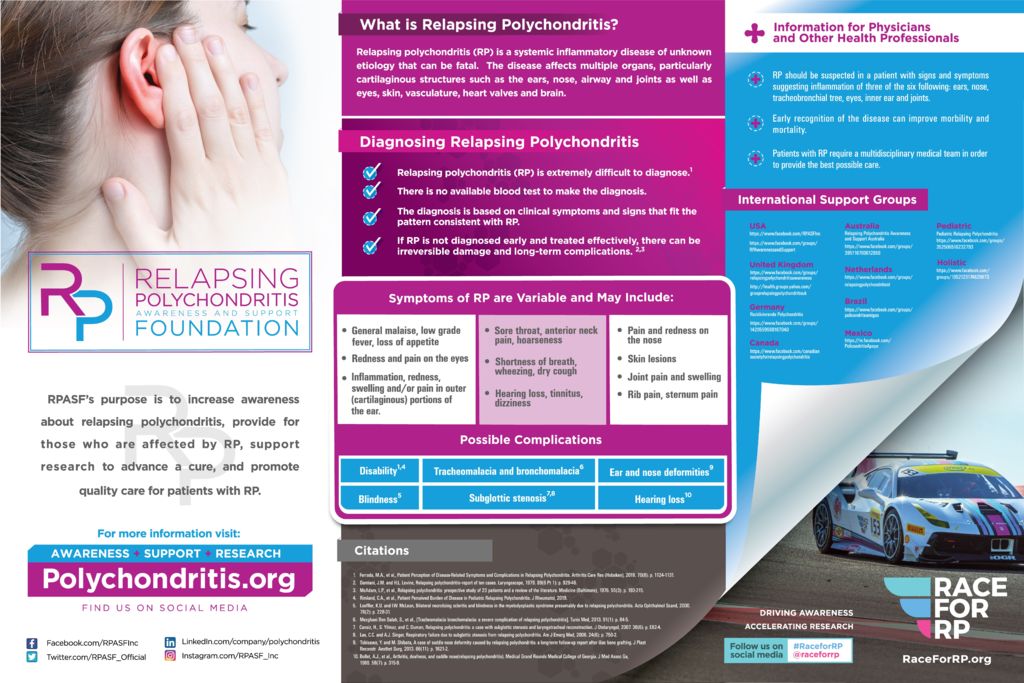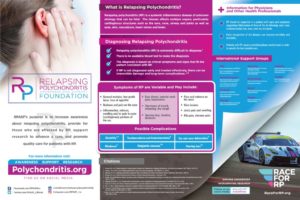
Primary Care Physicians Now Have Resources to Diagnose a Rare Autoimmune Disease: Relapsing Polychondritis
RPASF creates a collaborative benchmark resource on relapsing polychondritis outlining the common symptoms, possible complications, diagnostic checkpoints, and key information to aid physicians and health care professionals as well as patients suffering from this rare autoimmune disease.
Read the original press release here
NEW YORK (PRWEB) MAY 21, 2019
A primary care physician sees a patient with unexplainable symptoms: a combination of general malaise, low grade fever, redness and pain on the eyes, inflammation and pain in the ear, shortness of breath, pain and redness on the nose, skin lesions, joint pain, rib pain, hearing loss, dry cough, and wheezing. However, inflammation tests read normal; there is no diagnosable disease in the lungs; and no discernible problems with the ears. Thanks to the Relapsing Polychondritis Awareness and Support Foundation (RPASF), that doctor now has the easy-to-understand, peer-reviewed resources to know that her/his patient may have a rare autoimmune disease.
First described in 1923, relapsing polychondritis (RP) has been studied ever since, but, until recently,with limited progress. Researchers have confirmed that the disease causes the body to attack its own cartilage and can prove fatal, especially if left untreated, but there are currently no biomarkers to provide a confirmed diagnosis, nor is it known what causes flare-ups. The disease tends to be more prevalent in Caucasians and women, but it seems to affect all ethnic groups and be uncorrelated with any specific environmental factor, further complicating the diagnostic process.
Relapsing polychondritis is also a rare disease, making it unlikely that doctors will consider it, if they are even aware of it to begin with. According to Dr. Marcela Ferrada, Lawrence Shulman Scholar and relapsing polychondritis researcher at the NIH’s National Institute of Arthritis and Musculoskeletal and Skin Diseases (NIAMS), the incidence is estimated to be between .71 to 3.5 per million per year. “But,” she says, “I believe that this may be because RP is under-diagnosed and under-recognized. I suspect that this disease is more common than people think.”
To equip physicians with the knowledge necessary to spot the disease, RPASF has created a new resource that’s unique in two important ways. First, it condenses the available information on RP into succinct, memorable categories, including common symptoms, possible complications, a diagnostic checklist, and information specifically for physicians and health care professionals. For potential patients, it also provides a list of support groups.
Second, it uses information from an increasingly collaborative group of outstanding RP researchers, which is critical for a rare disease with limited literature, some of which is outdated. “Most of what you first see after you’re diagnosed with RP is ‘It can be fatal,’” says Rachel Wollan, an RP patient living in Indiana. “When that’s pretty much all you see when you’re doing research on your own, it can be pretty depressing.”
Because of the difficulty of making the diagnosis, many RP sufferers go years without a diagnosis, and while they search for answers, the disease does irreparable damage to their body. However, with the new poster from RPASF, medical care professionals now have tools to better serve these patients. In the words of Dr. Joseph Ahearn, chair of the Allegheny Health Network Autoimmunity Institute, “It doesn’t matter if it’s a rare disease if you have it.”
[button title=”View and Download the Poster Here” link=”http://www.polychondritis.org/wp-content/uploads/2019/05/Relapsing-Polychondritis-RP-Poster.pdf?fbclid=IwAR0dEw2yfNTSUhQs6L8YS6nq_PWREGGQW8BpRvKnysrIYIPhUZ1pSrjhqFM” target=”_blank” align=”” icon=”” icon_position=”” color=”blue” font_color=”white” size=”2″ full_width=”” class=”” download=”” rel=”” onclick=””]
About Relapsing Polychondritis
Relapsing polychondritis (RP) is a systemic inflammatory disease of unknown etiology that can be fatal. The disease affects multiple organs, particularly cartilaginous structures such as the ears, nose, airway and joints as well as eyes, skin, vasculature, heart valves, and brain. For more information, visit http://bit.ly/RP_Poster.
About Race for RP
Race for RP supports research, awareness programs, and cares for those who are affected by relapsing polychondritis and related diseases. For more information, visit Race for RP’s website and watch the Race for RP animation.
About RPASF
RPASF’s purpose is to increase awareness about relapsing polychondritis, provide for those who are affected by RP, support research to advance a cure, and promote quality care for patients with RP. For more information, visit RPASF’s website.
About AHN Autoimmunity Institute
The AHN Autoimmunity Institute is an unprecedented venture focused on advancing the diagnosis, treatment, prevention and cure of all autoimmune diseases, of which there are more than 100. The Institute’s focus is on improved outcomes, increased patient satisfaction and quality of life, and decreased cost of care, through collaborative multispecialty care, cutting-edge research, advocacy and education in attacking these chronic diseases. For more information, visit http://www.ahn.org/autoimmunity-institute.
Join our email list
Receive the latest blog articles, news, and more right to your inbox!
Related articles you might be interested in

Meet Erika: Battling 6 Autoimmune Diseases—and Advocating for Millions

Autoimmune Association Announces Inaugural Hope Journey Walk Inviting Communities to “Lace Up for Hope”

Art with a Mission: John von Bergen Gives Back to Autoimmune Community Through Sales

Study Reveals Top Environmental Concerns Impacting Autoimmune Patients
Find more resources on autoimmunity
Learn more about autoimmunity, diagnosis tips, how to find a physician, and more.